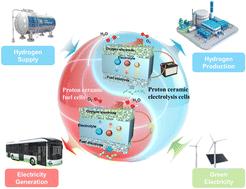在723k以下工作的可逆质子陶瓷电化学电池的进展:理论见解和实验进展
IF 9.5
2区 材料科学
Q1 CHEMISTRY, PHYSICAL
引用次数: 0
摘要
将陶瓷电化学电池的工作温度降低到723 K以下,可以有效地减轻组件的降解,降低系统成本。与传统的氧离子导电陶瓷电化学电池相比,可逆质子陶瓷电化学电池(R-PCECs)由于质子传导的活化能低,在723 K以下具有更大的工作潜力,因此在过去的十年中受到了广泛的研究关注。然而,在低温下保持合理的性能和效率仍然是一个关键的挑战。本文综述了在723k以下运行的R-PCECs的理论见解和最近的实验进展。在理论方面,综述了一维电荷输运模型、电极动力学/极化模型和二维/三维多物理场模型,并对现有模型及其模拟结果进行了批判性评价,特别是法拉第效率。实验上,提高电解质,氧电极和燃料电极性能的有效策略进行了系统的审查和批判性的分析。此外,还讨论了先进计算方法的潜力,如高通量计算和机器学习辅助方法。在全面和批判性讨论的基础上,确定了723k以下运行的R-PCECs发展中的具体问题,并概述了未来的研究方向。本文章由计算机程序翻译,如有差异,请以英文原文为准。

Advances in reversible protonic ceramic electrochemical cells operated below 723 K: theoretical insights and experimental developments
Lowering the operating temperature of ceramic electrochemical cells below 723 K can efficiently mitigate component degradation and reduce system costs. Compared with traditional oxygen-ion conducting ceramic electrochemical cells, reversible protonic ceramic electrochemical cells (R-PCECs) offer greater potential for operation below 723 K due to the low activation energy for proton conduction, thus attracting significant research attention over the past decade. However, maintaining reasonable performance and efficiency at reduced temperatures remains a critical challenge. This review provides a comprehensive summary of theoretical insights and recent experimental advancements in R-PCECs operated below 723 K. In the theoretical aspect, one-dimensional charge transportation models, the kinetics/polarization of electrodes, and two/three-dimensional multi-physics models are summarized, with a critical evaluation of existing models and their simulation results, especially for faradaic efficiency. Experimentally, efficient strategies for enhancing electrolyte, oxygen electrode, and fuel electrode performance are systematically reviewed and critically analyzed. Additionally, the potential of advanced computational approaches, such as high-throughput computation and machine learning-assisted methods, is discussed. Based on the comprehensive and critical discussion, detailed issues in the development of R-PCECs operated below 723 K are identified, and prospective research is outlined.
求助全文
通过发布文献求助,成功后即可免费获取论文全文。
去求助
来源期刊

Journal of Materials Chemistry A
CHEMISTRY, PHYSICAL-ENERGY & FUELS
CiteScore
19.50
自引率
5.00%
发文量
1892
审稿时长
1.5 months
期刊介绍:
The Journal of Materials Chemistry A, B & C covers a wide range of high-quality studies in the field of materials chemistry, with each section focusing on specific applications of the materials studied. Journal of Materials Chemistry A emphasizes applications in energy and sustainability, including topics such as artificial photosynthesis, batteries, and fuel cells. Journal of Materials Chemistry B focuses on applications in biology and medicine, while Journal of Materials Chemistry C covers applications in optical, magnetic, and electronic devices. Example topic areas within the scope of Journal of Materials Chemistry A include catalysis, green/sustainable materials, sensors, and water treatment, among others.
 求助内容:
求助内容: 应助结果提醒方式:
应助结果提醒方式:


